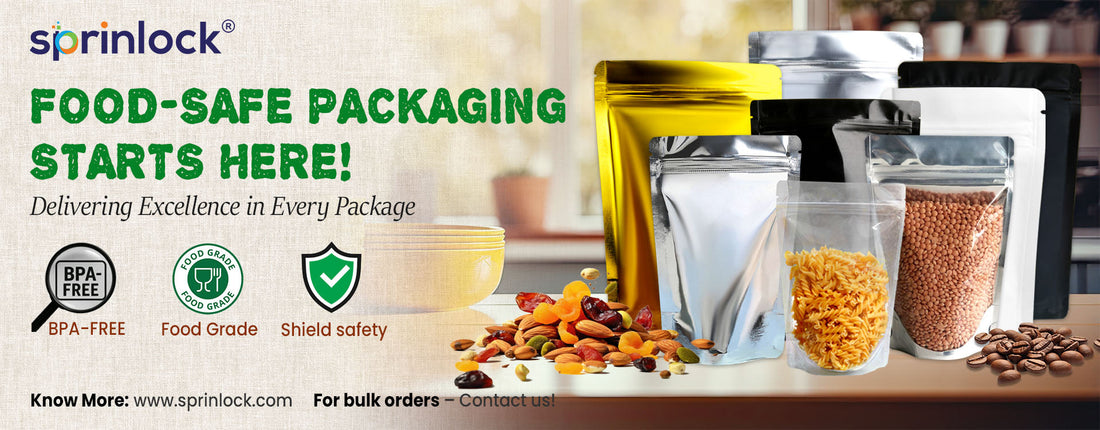When it comes to food packaging, safety is the top priority. Consumers and businesses alike want to ensure that the packaging used doesn’t compromise food quality or health. One of the most debated topics is plastic pouches—are they really safe for food? Let’s explore the facts and understand what makes plastic pouches food-grade and safe. ✅
1. What Are Food-Grade Plastic Pouches? 🏷️
Food-grade plastic pouches are made from materials that comply with strict food safety regulations. These materials do not leach harmful chemicals into food and are designed to maintain the freshness, taste, and texture of the contents.
Common Food-Grade Plastics & Their Uses
|
Plastic Type |
Features |
Used For |
|
PET (Polyethylene Terephthalate) |
Strong, lightweight, moisture-resistant |
Snacks, beverages, dried foods 🥤🍪 |
|
PE (Polyethylene) |
Flexible, non-toxic, FDA-approved |
Frozen foods, dairy products 🧀❄️ |
|
PP (Polypropylene) |
Heat-resistant, durable, microwave-safe |
Ready-to-eat meals, condiments 🍜🍯 |
|
LDPE (Low-Density Polyethylene) |
Soft, squeezable, moisture-resistant |
Bread bags, sauce pouches 🍞🥫 |
|
BOPP (Biaxially Oriented Polypropylene) |
High clarity, grease-resistant |
Chips, candy, nuts 🍫🥜 |
All these plastics are FDA-approved and tested to ensure they do not release harmful substances into food.
2. How to Identify Safe Plastic Pouches for Food? 🔎
Not all plastic packaging is food-safe. To ensure the safety of your food, look for:
✅ FDA or FSSAI Approval – Ensure that the plastic meets food safety standards.
✅ BPA-Free Label – Bisphenol A (BPA) is a harmful chemical found in some plastics; always choose BPA-free pouches.
✅ Recycling Symbols – Check for numbers 1, 2, 4, or 5 in the recycling triangle, as these are food-safe plastics.
✅ Odor-Free & Non-Reactive – Safe plastics do not react with food or release odors.
Sprinlock offers stock and custom food-grade plastic pouches that meet all necessary safety regulations, ensuring quality and freshness. 🌱
3. Are Plastic Pouches Safer Than Other Materials? 🤔
While paper and glass are alternative packaging materials, plastic pouches offer unique benefits:
|
Material |
Pros |
Cons |
|
Plastic Pouches |
Lightweight, moisture-resistant, durable, cost-effective |
Environmental concerns if not recycled properly 🌍 |
|
Paper |
Biodegradable, eco-friendly |
Less durable, prone to tearing, not moisture-resistant 📄💧 |
|
Glass |
Recyclable, non-reactive |
Heavy, breakable, costly 🍶💰 |
|
Metal (Aluminum Foil) |
Excellent barrier, keeps food fresh |
Non-flexible, higher production cost 🏭 |
Plastic pouches provide an excellent balance between safety, convenience, and cost, making them an ideal choice for food packaging when responsibly used. For digitally printed or custom food-safe pouches, check out Sprinpak. 🎨
4. How to Ensure Safe Use of Plastic Pouches? 🛡️
Even food-safe plastic pouches need to be used correctly to maintain safety:
🔹 Store in a cool, dry place – Avoid exposure to excessive heat. 🔥
🔹 Do not reuse single-use plastic pouches – They may degrade over time. 🔄
🔹 Check for food compatibility – Some plastics are not suitable for acidic or hot foods. 🌡️🍋
🔹 Follow expiry guidelines – Over time, plastic may degrade and lose its protective properties. ⏳
Key Takeaway: Choose Food-Safe Plastic Wisely! 🎯
The safety of plastic pouches for food depends on the materials used, compliance with regulations, and proper usage. When sourced from reliable manufacturers Sprinlock and Sprinpak, food-grade plastic pouches are safe, efficient, and practical for packaging needs.
So, the next time you choose a food pouch, look beyond the material—check for certifications, safety labels, and proper storage guidelines. ✅
👉 Need safe, high-quality plastic pouches? Choose only the best for your products! 🚀

